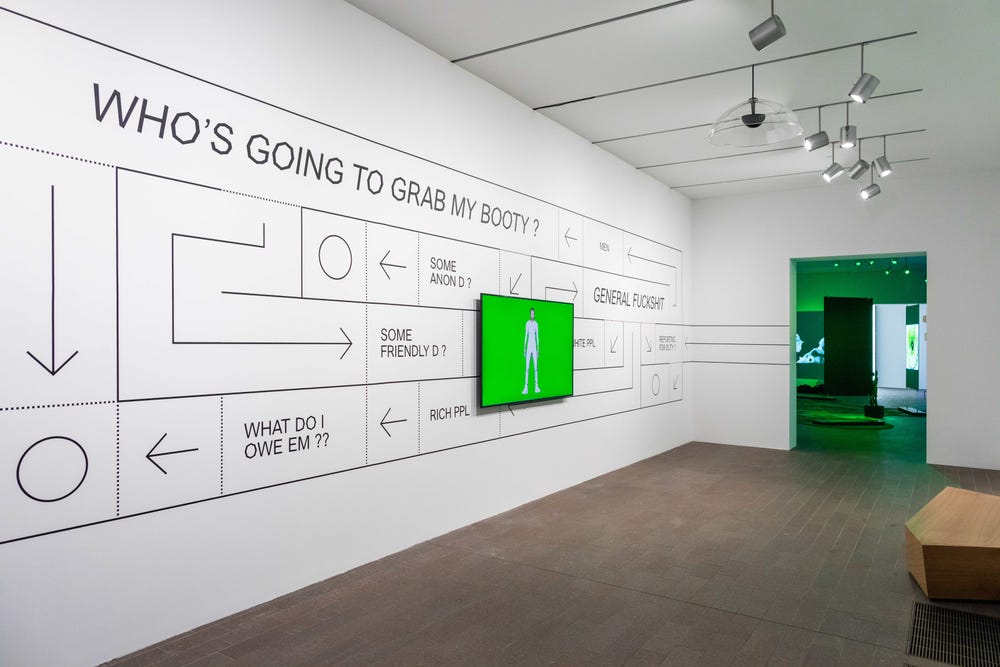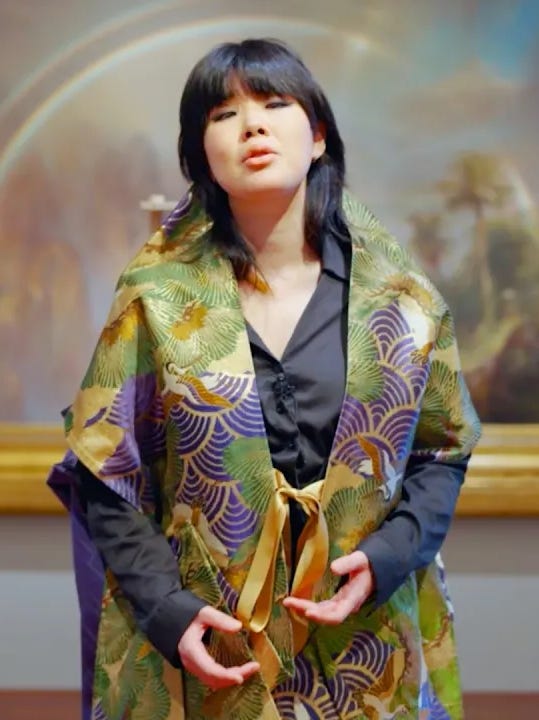With nearby Silicon Valley driving the development of artificial intelligence, or AI, Uncanny Valley: Being Human in the Age of AI is the first major museum exhibition to reflect on the political and philosophical stakes of AI through the lens of artistic practice. This series highlights select artworks included in the exhibition.
Martine Syms co-opts the language and tools of technology to reveal the embedded ideologies of representation and their amplification in an increasingly mediated and automated world. Fascinated by the ways we “disidentify, negotiate, or change [ideologies of technology] to fit real life,” she creates fictive spaces in which to dissect the cultural codes that Black women, in particular, are expected to heed in a world designed for white male bodies. Although identity politics are central to her practice, she approaches them in a documentary rather than didactic manner, expanding on issues in multifaceted works that encompass video, installation, and performance.
Syms charts “the way in which Black identity is constantly being shaped through the experience of surveillance, and how technology mediates perceptions of race.” Syms’s statement refers specifically to the increased influence of popular cinema on Black American identity during the time of the Great Migration. However, her words can also be applied to more recent ways in which social media has influenced public presentations of Black identity and enabled forms of surveillance and self-surveillance. Discussing the pervasive presence of social media and its impact, scholar Shoshana Zuboff writes, “Ubiquitous connection means that the audience is never far, and this fact brings all the pressures of the hive into the world and the body.” She continues: “The idea here is that people—especially, though not exclusively, young people—now censor and curate their real world behavior in consideration of their own online networks as well as the larger prospect of the internet masses.” Syms’s work draws on this phenomenon and on larger online culture to uncover pertinent metaphors for Black identity and to formulate succinct expressions of cultural differences.
Martine Syms, Mythiccbeing, 2018 and Threat Model, 2018. Installation view from Uncanny Valley: Being Human in the Age of AI. © Martine Syms, courtesy Sadie Coles HQ, London. Photography by Gary Sexton
Syms’s Threat Model visually collapses digital and psychological space. The work’s title refers to the practice of threat modeling, which involves mapping a system’s vulnerabilities in order to maximize its security. In oversize vinyl letters that underscore the sense of anxiety conveyed by the text, the work presents a large-scale representation of a threat map. But rather than mapping a network’s vulnerabilities, it reveals the artist’s own weak spots and internal negative thoughts—what she describes as her “shame space.” Although specific to Syms, her compulsively recurring thoughts on weight, sex, money, race, friends, and music are widely relatable.
Martine Syms, Mythiccbeing, 2018 and Threat Model, 2018. Installation view from Uncanny Valley: Being Human in the Age of AI. © Martine Syms, courtesy Sadie Coles HQ, London. Photography by Gary Sexton
This self-directed negativity also appears in Mythiccbeing, in which Syms appropriates her own body to simulate what she calls an “anti-Siri.” “Mythiccbeing—thicc’ ’cause she’s got hips,” she says of the bot. This human-scale instance of AI, which Syms has named “Teeny,” responds to its audience through text, acting in a deliberately and exaggeratedly self-centered manner. Texting Teeny is like consoling a friend who has had a bad day. The bot prefaces the conversation by informing the viewer that their upcoming exchange is not about them and that very little of their input is going to be necessary. Teeny’s self-absorption tears viewers out of their own subject-oriented worldviews, forcing them to decenter and actively consider the bot’s words.
Syms has said that in creating Mythiccbeing she was thinking about “some kind of agent that didn’t want to serve you.” Her assertive avatar upends the subservience of digital assistants like Apple’s Siri and Amazon’s Alexa, whose overtly gendered identities encourage an association between obedience and femininity. Such positioning suggests that the views perpetuated by the male-dominated world of engineering are another instance of built-in bias to overcome.
Text by Janna Keegan, Assistant Curator of Contemporary Art at the Fine Arts Museums of San Francisco; from Beyond the Uncanny Valley: Being Human in the Age of AI, Fine Arts Museums of San Francisco. Available for purchase through the Museums Stores.
Learn more about Uncanny Valley curated by Claudia Schmuckli, Curator in Charge of Contemporary Art and Programming.
Further Reading
- “Martine Syms in Conversation with Beatrix Ruf: ‘The Image Is Now Part of My Flesh,’” Mousse Magazine 67 (April 1, 2019): 191–195.
- Maisie Skidmore, “Martine Syms, Artist, on Andrea Lawlor’s Paul Takes the Form of a Mortal Girl,” Another Magazine, September 20, 2018, 120.
- Dylan Jones, “Martine Syms: Don’t Be Afraid to Be Narcissistic,” GQ London, September 9, 2018,
- https://www.gq-magazine.co.uk/article/martine-syms-artist-interview-2018.
- Shoshana Zuboff, The Age of Surveillance Capitalism (New York: Public Affairs, 2019), 472.
- Bryony Stone, “ ‘Fear and Desire for Connection and the Blocks to It’: Artist Martine Syms on Her Exhibition Grand Calme,” It’s Nice That, September 20, 2018, https://www.itsnicethat.com/features/martine-syms-art-200918.





